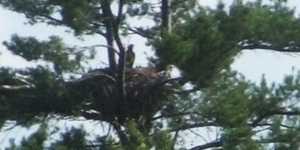Fact Sheet: Bald Eagles
WHAT’S IN A NAME?
Bald Eagle: Haliseetus leucocephalus
In Old English, balde meant “white”, consequently, “Bald-headed Eagle” meant “White-headed Eagle” and later just became “Bald Eagle”. Its scientific name, Haliaeetusis from the Greek halos, “sea” and aetus, “eag1e “Leucocephalus is from the Greek leucos, “white”, and kelphalus, “head.”
HISTORY
Experts estimate that 25-75 thousand bald eagles may have soared over the continental U.S. at the time when the first settlers arrived. Due to loss of habitat, depredation and DDT, fewer than 3,000 were left in the lower 48 states by the early 1970’s. With positive human intervention, the eagle’s decline has largely been halted. In many areas of the country its numbers are actually growing. Nesting sites have expanded throughout Minnesota and Wisconsin. Over 20 active nests have been recorded at Tamarac.
IDENTIFICATION
Length: Males = 32 in., Females 42 in.
Weight: Males = 8-10 lb., Females = 12-14 lb.
Wingspan: Males = 6 1/2 ft., Females 8 ft.
Flight: Slow wingbeats.
Soaring: Wings flat or slightly v’d.
Note: White feathers on the head and tail do not appear for 4-5 years. Thus, immature bald eagles are easily mistaken for golden eagles.
Note: Where the Bald Eagle and Turkey Vulture are found together, they can be separated at a great distance by their manner of soaring: the Bald Eagle with flat wings; the Turkey Vulture with a distinct V.
HABITS
Eating: Efficient predators. Main diet is fish and ducks. Food usually obtained in easiest way possible, including scavenging and stealing from other bald eagles and ospreys.
Nesting: Near water. Usually within 100 miles of where they were raised. Reused nest may reach 4,000 lbs.
Breeding; Mate for life. If one dies, survivor wilt accept new mate. Lay 1-3 eggs, once a year. Eggs hatch in about 35 days. Young fly within 3 months and leave the nest around 4 months. Both parents build the nest and care for the young.
Roosting: ATinter communal night roosts ranging in size up to 100 birds. Spend
considerable time perched, up to several days at a time.
DISTRIBUTION
Breeding Areas: Alaska, Canada, U.S. Coasts, mountain elevations, and the upper Mississippi River valley.
Winter Areas: Lower 48 states.
EAGLES AT TAMARAC

Eagles nest at Tamarac NWR
|
Each year, as many as 21 nesting pairs make Tamarac their summer home. They generally migrate in correlation with duck migrations, preying upon the old and weak. Eagles can be viewed at Tamarac between March and November and occasionally during the winter months. These majestic birds can often be seen soaring over the lakes, or perched in trees at the edge
of open water. |
|
|
